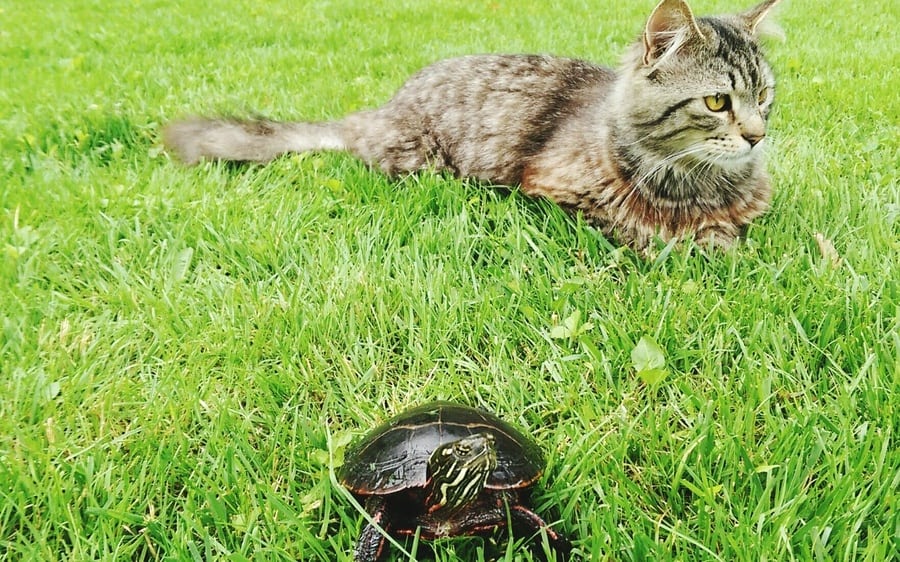Cat owners often wonder if it is a good idea to introduce a pet turtle into the house. For good reason, many pet owners are cautious about mixing turtles and cats but I do believe they can coexist very nicely if approached the proper way.
Cats and pet turtles are not naturally compatible because cats are often curious and interactive with turtles but if you can get your house cat to ignore or tolerate your pet turtle, they can both coexist nicely.
Most pet turtles and cats can get along in specific scenarios, but cats may cause harm on rare occasions. There’s a low tendency for the cat to cause harm.
So, you can still ensure the pet turtle gets acquainted with the cat. It’s the owner’s responsibility to stay close to both animals to avoid any accidents. Keep reading to know more about taking care of your cats and pet turtles.

Are Turtles & Cats Compatible?
Cats and pet turtles are not naturally compatible. For this reason, people often avoid keeping both of these animals in the same vicinity without boundaries. Due to a cat’s instinct, they have a high chance of attacking and harming the turtles. However, domesticated cats typically ignore turtles and allow them to enjoy their regular activity.
The cats approach turtles out of curiosity and show their predatory instincts in some cases. The relationship between a domestic cat and a turtle is often not life-threatening for either party. There are unique scenarios where cats, especially wild ones, can severely injure a turtle, but it isn’t the norm.
Even when cats don’t inflict any direct injury to turtles, they can stress out these mammals. Due to high levels of stress, turtles typically refuse to eat. The lack of essential nutrients for a turtle leads to starvation, which is life-threatening.
Pet turtles may seem harmless, but their bacteria can cause cats to become significantly ill. According to the U.S. Food and Drug Administration, turtles commonly carry Salmonella bacteria in the outer skin and shell.
Salmonella in cats and humans can be life-threatening, even though turtles with it may not exhibit signs of illness. Cats may develop diarrhea, fever, nausea, and vomiting.
Role of Personality in Compatibility
It may be difficult to predict how a cat and turtle would often interact. The level of interaction between these pets typically depends on their personalities.
Most cats display the following characteristics based on their personality:
- Outgoing Cats: These cats love exploring, investigating, and getting into trouble. Pet owners who have cats like this should know that they need mental stimulation. Hence, they need to engage these pets to prevent them from displaying destructive behaviors.
- Friendly Cats: While most cats are independent or ambivalent, many display obvious friendly behaviors. Most cats with this personality are typically Persian and Exotic Shorthair.
- Curious Cats: All cats exhibit signs of curiosity. When they are around turtles, their level of curiosity can cause harm.
- Shy Cats: Shyness is a typical personality in most cats. However, this personality doesn’t veer toward their interaction with turtles. Most times, shyness applies to humans.
It’s helpful when the turtle’s personality slightly matches your cat’s. Here’s a little detail about pet turtles’ personalities for compatibility:
- Shy: Similar to cats, turtles are also shy. However, unlike cats, they also display this to humans and animals inclusive. The cat’s curiosity may not be compatible with the shyness of a turtle.
- Quiet: Turtles have naturally quiet personalities as it helps them stay stealthy in the wild. Moreover, pet turtles typically make low-frequency sounds to stay away from dangers.
- Harmless: Most turtles don’t cause any harm unprovoked. However, the bacteria they carry can harm individuals and other animals.
How to Introduce a Turtle to Cat
When introducing a turtle to a cat, it’s essential to consider your turtle’s overall comfort. Don’t introduce the cat to a small turtle for the mammal to carry. All the steps to introduce the turtle shouldn’t cause discomfort or stress to the pet turtle. Follow these steps to introduce a turtle to a cat:
Step One: Find a Good Match
Before introducing a turtle to a cat, it’s crucial to ensure that they have close similarities in personality. An overly curious cat may not be the best match for your pet turtle. Ensure the cats are domesticated before bringing them close to the turtles. Most domesticated cats show less predatory instincts compared to wild ones.
Even with domesticated cats, it’s imperative to ensure that they are not overly outgoing. Most outgoing cats love exploring and finding out new things.
Hence, they may not be suitable for pet turtles as their exploration and curiosity get them significantly stressed. Apart from reviewing the personalities of the animals, ensure the turtle wouldn’t make the cat ill due to Salmonella bacteria.
Step Two: Provide Separate Safe Regions for Turtle and Cat
When you bring any of these pets home, ensure that they remain separated. The turtle should be in a house region where the cat wouldn’t reach. Pet owners may also keep their cats in cages for specific periods to prevent clashes.
Step Three: Keep the Introduction Slow, Short, and Positive
When introducing the turtle to the cat, ensure to keep it slow, short, and positive. It’s advisable to use leashes and gates when introducing them. Use leashes on the cat to prevent them from hurting the turtles.
Stay careful when using a leash on the cat to avoid possible choking. If the cat seems to be struggling while it’s on the leash, stop or pause the introduction. As an owner, it’s imperative to ensure that the meeting doesn’t feel forced or overly uncomfortable for any party.
Step Four: Reward a Calm Outlook
If both the turtle and cat exhibit calm attributes, consider rewarding them with a treat. Once both animals become too focused or agitated, add significant distance or try the meeting later.
Can Cats & Turtles be Kept Safely Apart?
Cats and turtles can be kept safely apart with the appropriate tools like leashes and cages. Pet owners can also utilize other methods to separate them properly. For instance, creating no cat zones to avoid a clash is advisable. Note that having no cat zones in the home may involve scent, sound, taste, and touch deterrents.
Before getting a space for the turtle, consider checking for areas of the home that is the cat’s least favorite. If there are no such areas, consider creating one.
When pet owners work to keep cats and turtles safely apart, most of the work should be towards the cat. Here are some helpful tips to keep cats away from an area your turtle stays:
- Don’t Give the Cat Attention: Avoid giving attention once the cat enters the area where the turtle is. Every cat wants its owner’s attention, even if it’s negative. Hence, if the individual ignores their behavior, the cat will get bored and find something else to do somewhere else. Removing attention in specific scenarios may not always be practical.
- Keep the Door Closed: One of the most straightforward steps is closing or locking the door leading to the turtle’s space/tank. Cats hate closed doors because they are significantly social creatures with a high level of curiosity. Keeping doors closed may also make cats feel less territorial as they are significantly territorial pets.
- Make the area Uncomfortable: When pet owners make the turtle’s area uncomfortable for the cat, they develop less interest in showing up. Some examples of ways to make cats uncomfortable include playing loud music and spraying unappealing scents around.
- Remain Consistent: Cats can be very consistent in their goal to reach the turtle’s space. Hence, it’s imperative also to remain consistent in creating a no-cat zone for the turtle.
Can You Cat-Proof a Cage?
Pet owners can keep their turtles safe from cats by cat-proofing the enclosure or tank. However, it’s crucial to use a heat-proof metal tank cover. Ensure the screens can withstand clawing and high temperatures. Generally, the metal tank covers are inexpensive and can do a great job in protecting the turtles from cats.
Apart from using these metal tank covers to protect against cats, they also protect against exploding bulbs and broken glass. Ensure that the screen also allows UVB light through. Hence, it shouldn’t have an opaque form or be from Plexiglass or glass.
The most advisable surface of the screen should be mesh. Depending on the size of the gaps, the mesh helps reduce the amount of heat and light to turtles.

How to Get Cat to Leave Turtles
If owners are trying to get their cat to leave a turtle, consider the following techniques:
Use Scent Deterrents
Consider using unappealing smells once you notice the cat is making the turtle feel very uncomfortable. Scent deterrents make the area unattractive to cats, and they will avoid the region. Significant examples of the scents cats dislike include cinnamon, vinegar, citrus fruit, menthol, lavender, rosemary, thyme, rue, and mint.
Pet owners can purchase cat deterrents, but they should ensure that the essential oils are toxic for cats. If it’s challenging to get the best scent deterrents, consider mixing the necessary ingredients with a bit of water to save costs.
Utilize Sound Deterrents
Every cat dislikes loud noises, but turtles don’t have such problems. However, it’s best for the cat not to see the owner making such noises. So, yelling or clapping hands wouldn’t be effective.
Owners may need to be sneaky when making loud noises to prevent the cat from knowing the source of the sound. For instance, shake a jar filled with dry beans or stones if the cat rushes into the turtle’s space.
A more strategic approach to utilizing sound deterrents is using motion detector sprays on the surface of the turtle’s tank. So, when the cat moves near the turtle, the spray would startle the cat without the owner making any movements.
Consider Touch Deterrents
When preventing a cat from touching an enclosure, it’s advisable to utilize touch deterrents like sticky tapes. Most cats dislike sticky materials on their paws. So, they would avoid touching its tank. Another reasonable option is to use aluminum foil on the surface of the turtle’s enclosure or near it.
Apart from sticky materials and aluminum foil, plastics don’t appeal to cats for scratching purposes. Most cats scratch to sharpen their claws, and they can’t sink their nails properly in plastic, especially slippery vinyl plastic.
Microfiber is also a synthetic material that cats don’t like. These materials are durable and difficult to shed. Placing microfiber materials around the turtle’s tank will help keep the cat away from the vicinity.
Try Out Redirection
Once the cat begins to head in the turtle’s direction, use redirection. Even if the cat begins to focus on the area, start petting and playing with them for a distraction.
Ensure the cat has lots of enrichment toys and fun areas to play in. Give the cats the attention they want outside of the turtle tank area in the home.
Use Taste Deterrents
Use anti-chew bitter sprays around the turtle’s tank to prevent them from tampering with it. Most people smear hot sauce where they don’t want to see the cat, but that’s a messy option.
Instead of hot sauce, bitter apple sprays are more suitable for the turtle’s tank. Other considerations include citruses like limes, lemons, and oranges.
Are Turtles Compatible with Any Other Pets?
Turtles are naturally not compatible with any other pets. Having turtles around other pets can stress them out since they are not typically interactive.
The best bet for a pet turtle would be to find other turtle species with the same niche. For example, red-eared sliders may be compatible with painted turtles, river cooters, and yellow-bellied sliders.
Final Thoughts
Both pet turtles and cats are great pets but maybe not the best for cohabitation. Turtles can easily tolerate cats when owners control the mammal’s curiosity.
Most pet turtles also carry a bacteria called Salmonella, which can cause severe illnesses for the cat. Only consider introducing both pets if you’re ready for the effort of creating boundaries and keeping the turtle safe.
To learn if reptiles can recognize and bond with their owners, check out this helpful article. To learn if box turtles overeat and how much food is enough, check out this article.
